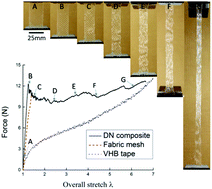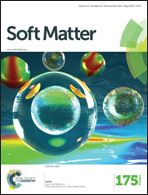A highly stretchable double-network composite†
Abstract
Inspired by the toughening mechanism of double-network (DN) hydrogels, a soft composite consisting of a fabric mesh and VHB tape layers was fabricated. The composite was as stiff as the fabric mesh, and as stretchable as the VHB tape. At certain compositions, the composite was significantly stronger and tougher than the base materials. The extensibility and toughness of the composite can be attributed to a damage delocalization mechanism similar to that of the DN gels. In the partially damaged regions, the fabric mesh fragmented into small islands, surrounded by the highly stretched VHB tapes. Accommodated by the finite sliding at the interface, the large deformation of the composite is highly non-affine. Just as the DN gels, the coexistence of the partially damaged and intact regions resulted in a stable necking in the composite when subjected to uniaxial tension. The propagation of the necking zone corresponded to a plateau on the stress–stretch curve. During cyclic loading, the composite also exhibited stress hysteresis with almost recoverable strain, similar to that in a DN gel. To rationalize these observations and to better understand the underlying physical mechanism, a simple 1D model has been developed for the damage evolution process in the composite. The predictions of the model have achieved good agreement with the measured properties of the composite of various compositions. Furthermore, the composite itself may also be regarded as a macroscopic model when studying the properties and toughening mechanism of the DN gels.


 Please wait while we load your content...
Please wait while we load your content...